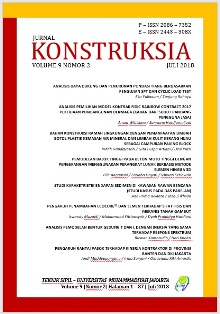ANALISIS DAYA DUKUNG DAN PENURUNAN PONDASI TIANG BERDASARKAN PENGUJIAN SPT DAN CYCLIC LOAD TEST
DOI:
https://doi.org/10.24853/jk.9.2.1-13Abstract
Abstrak: Pondasi merupakan bagian dari struktur bawah yang berperan penting dalam memikul beban struktur atas. Beban tersebut akan diteruskan pada tanah yang berada di bawah pondasi. Daya dukung tanah di bawah pondasi harus dapat menahan beban struktur tersebut. Apabila tanah tidak mampu memikul beban pondasi atau memiliki daya dukung yang kecil, maka penurunan yang berlebihan atau keruntuhan dari tanah akan terjadi. Kedua hal tersebut akan menyebabkan kerusakan struktur yang berada di atas pondasi. Daya dukung pondasi dalam dan besarnya penurunan pondasi dapat dihitung berdasarkan data tanah dari pengujian laboratorium atau pengujian di lapangan. Penelitian ini dilakukan berdasarkan beberapa pengujian di lapangan. pengujian lapangan yang dilakukan adalah penetrasi standar (SPT) dan pembebanan siklik (cyclic load test) pada tiang bor. Data N-SPT akan dikorelasikan dengan sifat fisis dan mekanis tanah. Daya dukung dan penurunan pondasi dalam dapat dihitung dengan metode Meyerhof, Resse dan White, serta interpretasi data pembebanan siklik dengan metode Davisson dan Chin. Hasil penelitian menunjukkan bahwa daya dukung ultimit tiang bor yang dihitung berdasarkan data N-SPT dengan metode Meyerhof sebesar 423,11 ton dan metode Resse-Wright sebesar 431,906 ton, sedangkan berdasarkan korelasi N-SPT dengan metode Resse-Wright sebesar 379,86 ton. Daya dukung ultimit berdasarkan pengujian cyclic load test adalah 430 ton, interpretasi data pengujian dengan metode Davisson sebesar 281,69 ton, dan metode Chin sebesar 499 ton. Penurunan terbesar berdasarkan data pengujian pembebanan siklik lebih besar daripada metode Vesic. Kata kunci: Pondasi tiang, pengujian SPT, cyclic load test, daya dukung tiang, penurunan Abstract: The foundation is a part of the bottom structure that an important role in bearing the burden of the upper structure. The load will be forwarded to the soil below the foundation. Soil bearing capacity of under foundation must be able to withstand the load of the structure. If the soil is unable to bearing the foundation load or has a small bearing capacity, an excessive reduction or collapse of the soil will occur. Both of these will cause damage to the structure above the foundation. Bearing capacity of the deep foundation and the magnitude of the reduction of the foundation can be calculated based on soil data from laboratory testing or testing in the field. This research was conducted based on several tests in the field. Field testing carried out is standard penetration (SPT) and cyclic load test on a drill pole. N-SPT data will be correlated with physical and mechanical properties of the soil. The bearing capacity and reduction of deep foundation can be calculated by the Meyerhof, Resse and White methods, as well as the interpretation of cyclic loading data with the Davisson and Chin methods. The results showed that the ultimate bearing capacity of the drill pole was calculated based on N-SPT data with the Meyerhof method of 423.11 tons and the Resse-Wright method of 431.906 tons, while based on the correlation of N-SPT with the Resse-Wright method of 379.86 tons. The ultimate bearing capacity based on cyclic load test is 430 tons, the interpretation of the test data with Davisson method is 281.69 tons, and the Chin method is 499 tons. The biggest decrease based on cyclic loading test data is greater than the Vesic method. Keywords: Pile Fondation, SPT test , cyclic load test, pile bearing capacity, reductionDownloads
Published
2018-08-27
Issue
Section
Articles

